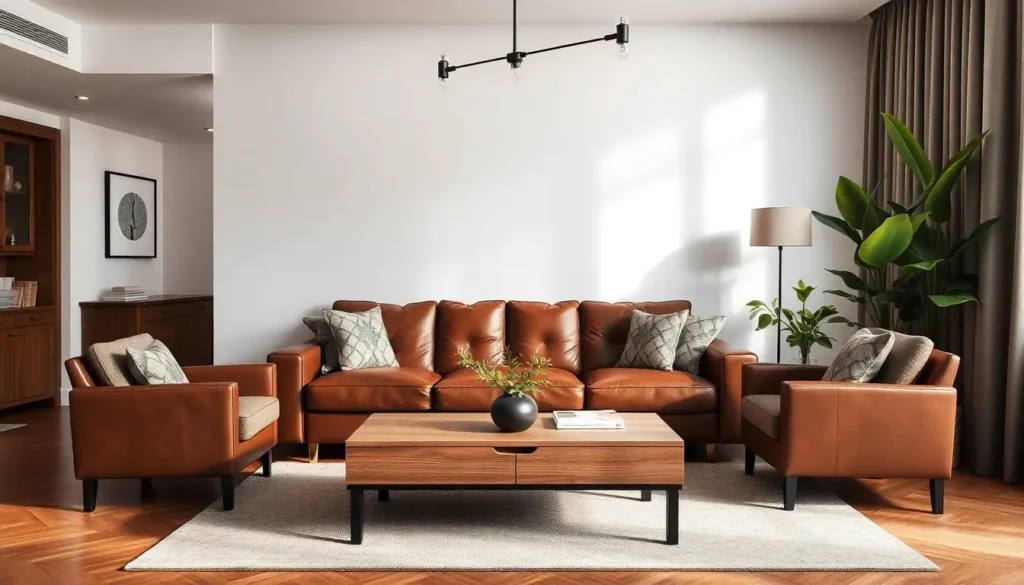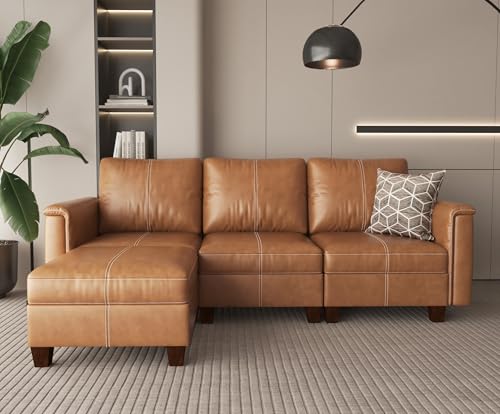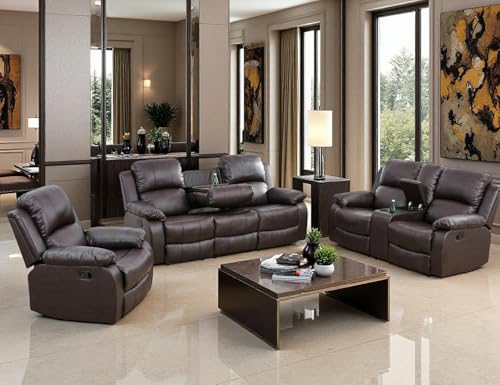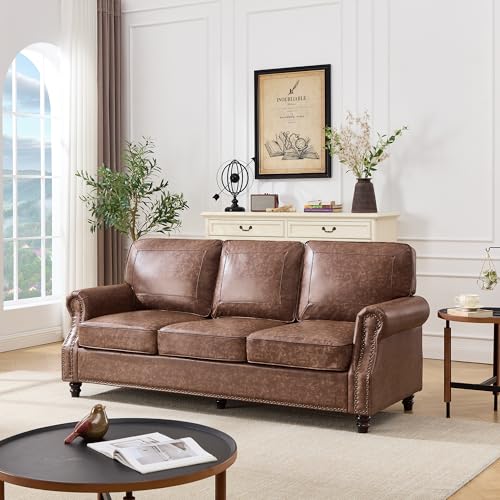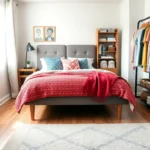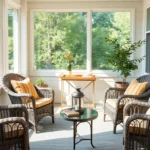We all know that a leather sofa can instantly transform any living room into a sophisticated sanctuary. Whether you’re drawn to the rich warmth of cognac brown leather or the sleek elegance of black Italian grain leather sofas create an undeniable focal point that speaks to both comfort and style.
The beauty of leather furniture lies in its incredible versatility. We’ve discovered that these timeless pieces work seamlessly with everything from rustic farmhouse décor to ultra-modern minimalist designs. The key is understanding how to balance textures colors and accessories to create a cohesive look that reflects your personal taste.
In today’s design industry leather sofas aren’t just furniture—they’re investment pieces that age beautifully and adapt to changing trends. We’ll show you how to maximize your leather sofa’s potential and create a living room that’s both inviting and Instagram-worthy.
Choose the Right Leather Sofa Style for Your Living Room
Selecting the perfect leather sofa style sets the foundation for your entire living room design. We’ll guide you through three popular styles that offer distinct aesthetic and functional benefits.
Traditional Chesterfield Sofas
Button-tufted elegance defines the timeless Chesterfield design that adds instant sophistication to any living space. We love how these leather sofas feature deep button tufting, rolled arms, and low backs that create visual interest through texture and shadow play.
Rolled arms and nail head trim complement traditional and transitional decor styles perfectly. Chesterfield sofas work exceptionally well in studies, formal living rooms, and spaces with rich wood furniture or vintage accessories.
Deep seating comfort makes these sofas ideal for long conversations and relaxation. We recommend choosing darker leather colors like cognac, chocolate brown, or classic black to enhance the traditional aesthetic and hide everyday wear.
Modern Minimalist Leather Designs
Clean lines and geometric shapes characterize modern leather sofas that emphasize simplicity and function. We appreciate how these designs feature straight edges, minimal decorative elements, and sleek silhouettes that create visual calm in contemporary spaces.
Low profiles and metal legs give modern leather sofas their distinctive floating appearance. These pieces work beautifully in open floor plans, loft spaces, and rooms with large windows where natural light can highlight the leather’s texture.
Neutral color palettes in white, gray, or black leather complement modern design principles. We suggest pairing these sofas with glass coffee tables, abstract artwork, and geometric throw pillows to maintain the minimalist aesthetic.
Sectional Leather Sofas for Large Spaces
L-shaped and U-shaped configurations maximize seating capacity while defining conversation areas in spacious rooms. We find that leather sectionals anchor large living rooms and create intimate gathering spots within open floor plans.
Modular components allow customization to fit your exact room dimensions and traffic flow needs. These flexible designs accommodate corner placements, room dividers, or wrap-around seating arrangements.
Entertainment-focused features like cup holders, reclining sections, and chaise lounges enhance comfort for movie nights and family gatherings. We recommend measuring your space carefully and ensuring at least 3 feet of walking space around the sectional for optimal room flow.
Select the Perfect Leather Color to Match Your Decor
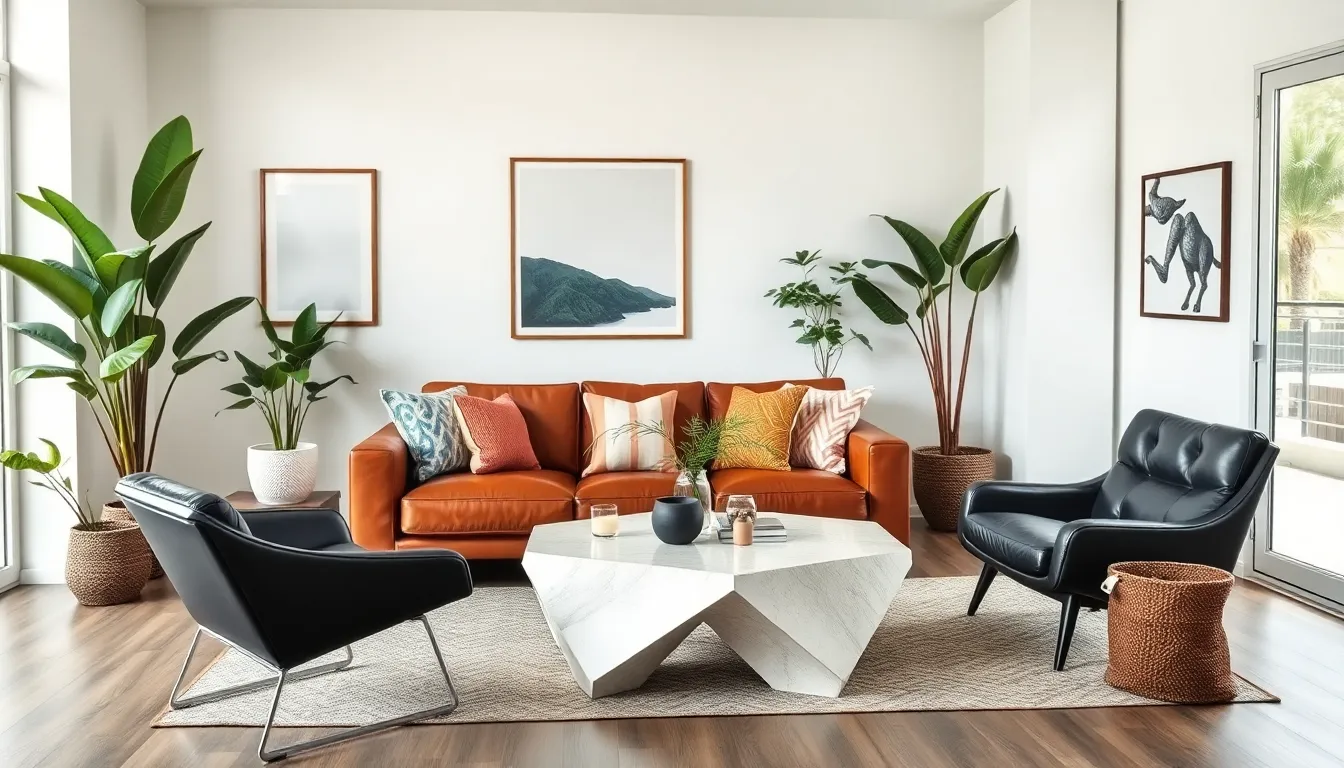
Choosing the right leather color becomes crucial when creating a cohesive living room design. We’ll explore three versatile leather color options that can transform your space while complementing various decorating styles.
Classic Brown Leather Options
Brown leather sofas create warmth and richness that instantly makes any living room feel more inviting. We recommend balancing this warmth with cool-toned accessories or wall colors like blue, green, or gray to prevent the space from feeling overwhelming.
Textures and patterns play a vital role in elevating brown leather furniture. Mix different materials such as knit throws, velvet cushions, and faux fur accents to add depth and coziness to your seating area. Geometric patterns, stripes, and floral designs work beautifully as accent pieces against brown leather’s neutral backdrop.
Earth tones complement brown leather naturally, creating harmonious color schemes throughout your living room. Burnt orange throw pillows and forest green plants enhance the organic feel while maintaining visual balance. These natural color combinations create a timeless appeal that works across multiple design seasons.
Sophisticated Black Leather Choices
Black leather sofas deliver a sleek, modern aesthetic that serves as a dramatic focal point in contemporary living rooms. We suggest elevating this bold choice with metallic accents like gold or silver side tables, chrome lighting fixtures, and brass decorative objects.
Neutral backgrounds work exceptionally well with black leather furniture, allowing your decorative elements to truly shine. White or light gray walls create striking contrast while providing a clean canvas for artwork and accessories. Bold artwork becomes more impactful when displayed against this sophisticated backdrop.
Contemporary styling reaches new heights when black leather anchors your furniture arrangement. Pair your sofa with glass coffee tables, minimal decor, and strategic lighting to maintain the sleek, urban vibe that black leather naturally provides.
Contemporary White and Light-Colored Leather
White and light-colored leather sofas transform living rooms by creating bright, airy atmospheres that feel more spacious. We’ve found these lighter options particularly effective in smaller rooms where maximizing natural light becomes essential for comfort.
Minimalist design principles work beautifully with light leather furniture, maintaining clean lines and uncluttered spaces. Pair white leather with simple geometric coffee tables, neutral area rugs, and carefully selected statement pieces to achieve sophisticated simplicity.
Maintenance considerations become more important with lighter leather colors, but the visual impact justifies the extra care. These sofas photograph beautifully and create Instagram-worthy living spaces that feel fresh and modern year-round.
Create a Balanced Color Palette Around Your Leather Sofa

Building a cohesive color scheme around your leather sofa ensures your living room feels intentional and polished. We’ll explore three key approaches to achieve this balanced aesthetic.
Complementary Wall Colors
Brown leather sofas work beautifully with cool-toned wall colors like pale blue, mint green, or soft gray to create visual contrast and balance. These cooler hues prevent the room from feeling too warm while allowing your brown leather piece to remain the focal point.
Cognac leather sofas shine against neutral or earthy wall tones such as beige, cream, or warm taupe. The neutral backdrop enhances the rich, warm character of cognac leather without competing for attention.
Darker leather pieces benefit from lighter wall colors that reflect more light and prevent the space from feeling heavy. Consider soft whites, light grays, or subtle off-white tones to brighten the room while maintaining sophistication.
Accent Colors That Pop
Patterned cushions and throws introduce vibrancy through stripes, florals, or geometric shapes that complement your leather sofa’s solid surface. Mix different textures like knit, velvet, and faux fur to create visual interest and tactile appeal.
Bold accent colors such as teal, pink, or gold work exceptionally well as cushion colors or decorative elements. These vibrant touches energize the space without overwhelming the leather’s natural elegance.
Metallic accents through picture frames, lamps, or coffee table accessories add sparkle and sophistication. Gold accents pair beautifully with brown and cognac leather, while silver complements black and gray leather pieces.
Neutral Tones for Timeless Appeal
Neutral throw pillows in beige, gray, or white maintain a classic look that won’t go out of style. These versatile colors complement any leather sofa style while allowing you to easily update other elements seasonally.
Textured rugs in neutral tones add warmth and depth while grounding your leather sofa’s earthy qualities. Choose materials like jute, wool, or cotton in cream, taupe, or soft gray to enhance the natural appeal.
Layered neutral accessories create a sophisticated, cohesive appearance that stands the test of time. Combine different shades of the same neutral family to add depth without introducing competing colors.
Incorporate Textures to Soften the Leather Look
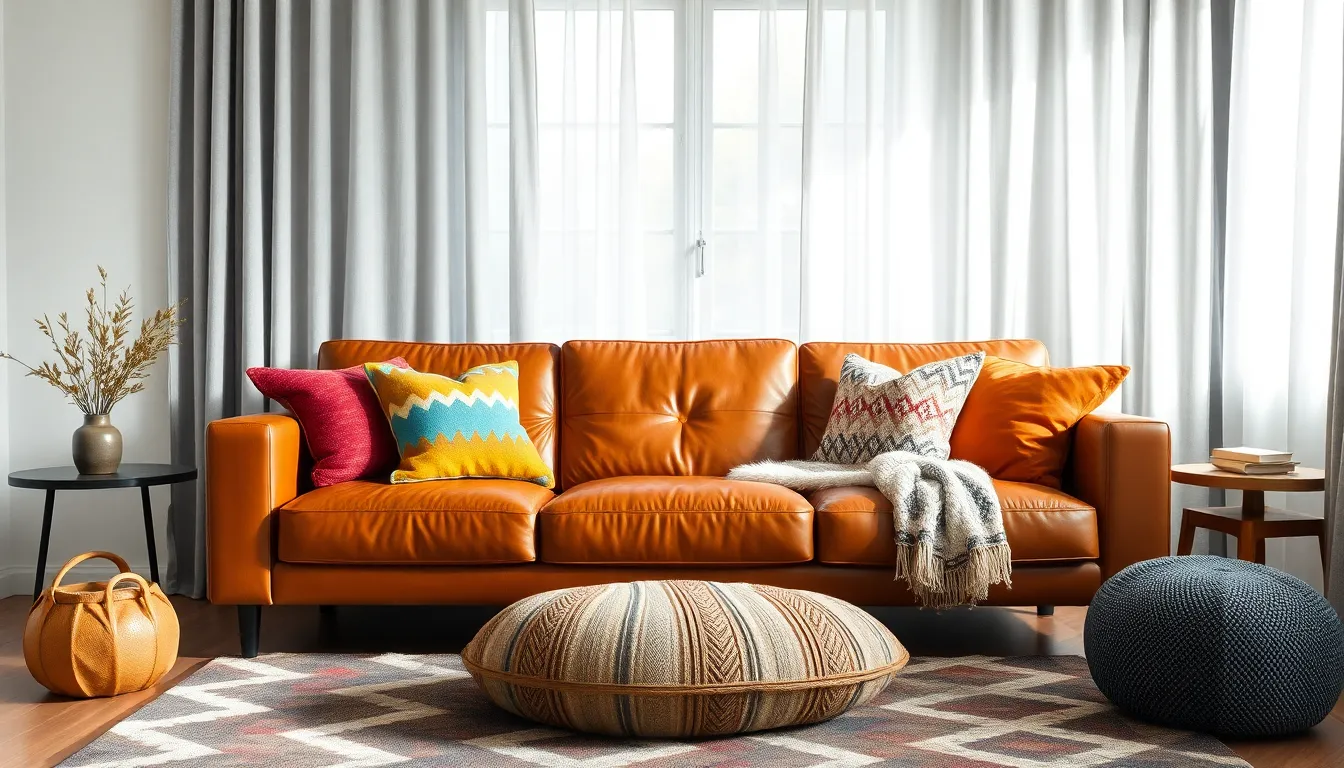
While leather sofas bring sophistication to our living spaces, we can enhance their appeal by introducing various textures that create visual interest and comfort. Mixing different textile elements helps balance the sleek leather surface with softer materials that invite relaxation.
Throw Pillows and Blankets
Color coordination plays a crucial role when selecting throw pillows and blankets for our leather sofas. Earth tones like burnt orange and forest green complement brown leather beautifully, while contrasting colors such as teal, pink, or gold create stunning visual impact.
Patterns add dynamism to our living spaces through stripes, florals, and geometric designs that prevent the room from feeling monotonous. We recommend mixing different pattern scales, pairing large prints with smaller motifs for balanced visual appeal.
Texture variety transforms our leather sofa’s aesthetic through knit throws, velvet cushions, and faux fur accents that create depth and coziness. These soft materials invite touch and make the sleek leather surface more approachable for daily relaxation.
Area Rugs and Floor Coverings
Warmth and comfort come naturally when we place area rugs beneath or near our leather sofas, creating defined seating areas that feel grounded and intentional. The right rug anchors our furniture arrangement while adding essential texture contrast to smooth leather surfaces.
Color palette coordination ensures our floor coverings complement rather than compete with our leather sofa’s rich tones. We suggest selecting rugs that echo accent colors from our throw pillows or artwork for a cohesive design approach.
Style matching becomes essential when choosing between traditional Persian rugs for classic leather pieces or contemporary geometric patterns for modern minimalist sofas. The rug’s design should enhance our overall room aesthetic rather than clash with existing elements.
Window Treatments and Curtains
Neutral shades provide the perfect backdrop for leather sofas by balancing their bold presence without overwhelming the space. We recommend choosing curtains in soft grays, warm whites, or gentle beiges that allow our leather furniture to remain the focal point.
Patterned options offer opportunities for creative expression when we want to introduce more visual interest to our living rooms. Geometric prints, subtle stripes, or botanical motifs can complement our leather sofa’s style while maintaining design harmony.
Fabric choices influence how our window treatments interact with leather textures, with linen and cotton providing casual contrast while silk or velvet adds formal elegance. The key lies in selecting materials that enhance rather than compete with our leather sofa’s natural beauty.
Design Around Different Living Room Layouts
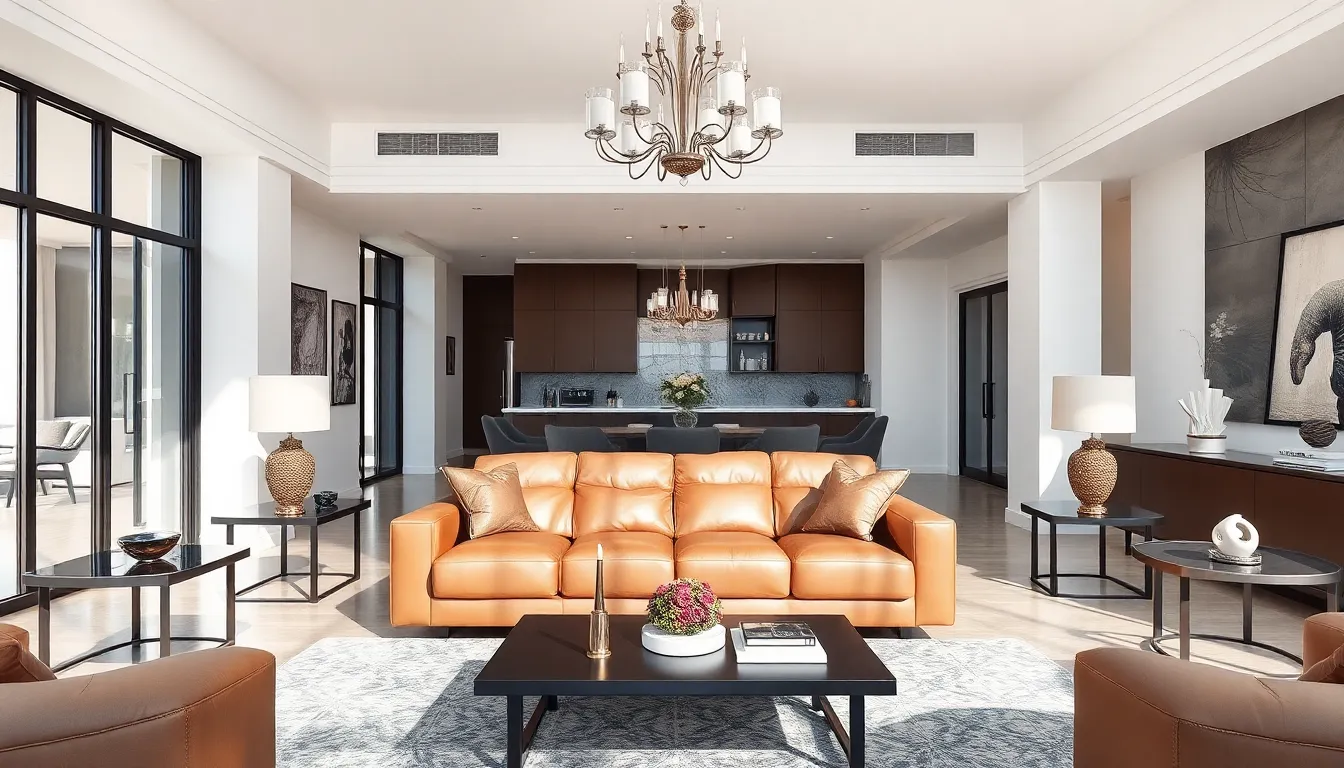
Leather sofas work beautifully across various living room layouts when positioned strategically to maximize both function and visual appeal.
Open Concept Living Spaces
Open concept layouts benefit from leather sofas that create natural room divisions while maintaining sight lines throughout the space. We recommend positioning your leather sofa against a wall or in a corner to establish a cozy conversation area within the larger room. Adding a console table behind the sofa helps define the seating zone without blocking views to other areas.
Stylish partitions can further enhance the separation between living and dining spaces while allowing light to flow freely. Consider using your leather sofa as an anchor piece that grounds the entire open floor plan and creates visual weight in the room.
Small Living Room Arrangements
Small living rooms require compact leather sofas paired with space saving furniture to maximize every square foot. We suggest choosing a streamlined leather loveseat or apartment sized sofa that won’t overwhelm the room’s proportions. Pairing it with a smaller coffee table creates better traffic flow and prevents the space from feeling cramped.
Wall mounted shelves eliminate the need for bulky storage furniture while keeping essentials within reach. Light colored walls help reflect natural light and create the illusion of more space around your leather furniture. Strategic placement near windows can make your leather sofa appear larger while brightening the entire room.
Formal Living Room Setups
Formal living rooms showcase leather sofas as sophisticated centerpieces that elevate the entire room’s elegance. We recommend positioning your leather sofa as the focal point and building the rest of the furniture arrangement around it. Elegant side tables on both ends create symmetry and provide surfaces for decorative accessories.
Stylish chandeliers add ambient lighting that highlights the leather’s rich texture and natural beauty. High quality artwork above the sofa completes the formal aesthetic and adds personality to the sophisticated setting. Consider adding matching leather chairs to create a complete furniture suite that enhances the room’s upscale atmosphere.
Add Complementary Furniture Pieces

Selecting the right complementary furniture enhances your leather sofa’s natural elegance while creating a cohesive living space. We’ll explore essential pieces that work harmoniously with leather seating to maximize both style and functionality.
Coffee Tables That Work with Leather
Material combinations create visual interest when pairing coffee tables with leather sofas. Wood coffee tables bring warmth and natural texture that complements brown leather beautifully, while metal options add industrial edge to modern spaces. Glass coffee tables offer transparency that prevents visual clutter around darker leather pieces.
Minimalist designs enhance the sleek appearance of contemporary leather sofas without competing for attention. Clean lines and simple geometric shapes allow your leather sofa to remain the focal point while providing essential surface space for drinks and decor.
Size proportions matter when selecting coffee tables for leather seating arrangements. We recommend choosing tables that measure approximately two-thirds the length of your sofa to maintain proper visual balance and ensure comfortable access from all seating positions.
Side Tables and Accent Chairs
Simple side table designs prevent visual clutter while providing practical surface space beside leather sofas. Wooden side tables with clean lines complement traditional leather pieces, while metal options work well with modern leather furniture styles.
Contrasting accent chairs create ever-changing visual interest in leather sofa arrangements. Gray accent chairs pair beautifully with brown leather sofas, while blue chairs add cool contrast to warm cognac leather tones. These color combinations prevent monotonous color schemes while maintaining design harmony.
Pattern mixing through accent chair upholstery adds personality to leather dominated spaces. Striped, floral, or geometric patterns on accent chairs create focal points that draw the eye while complementing the smooth leather texture of your main seating piece.
Storage Answers and Media Consoles
Storage ottomans serve dual purposes by providing hidden storage while offering additional seating or footrest options. These pieces help maintain clutter-free spaces around leather sofas while adding functional flexibility to your living room layout.
Media console materials should coordinate with your leather sofa’s style for seamless integration. Wooden media consoles create warm, traditional atmospheres with brown leather sofas, while metal consoles enhance modern leather furniture’s contemporary appeal.
Organization systems built into storage cubes keep living spaces tidy while complementing leather furniture’s sophisticated appearance. These answers help maintain the clean lines and elegant presentation that make leather sofas such compelling focal points.
Enhance with Proper Lighting Design
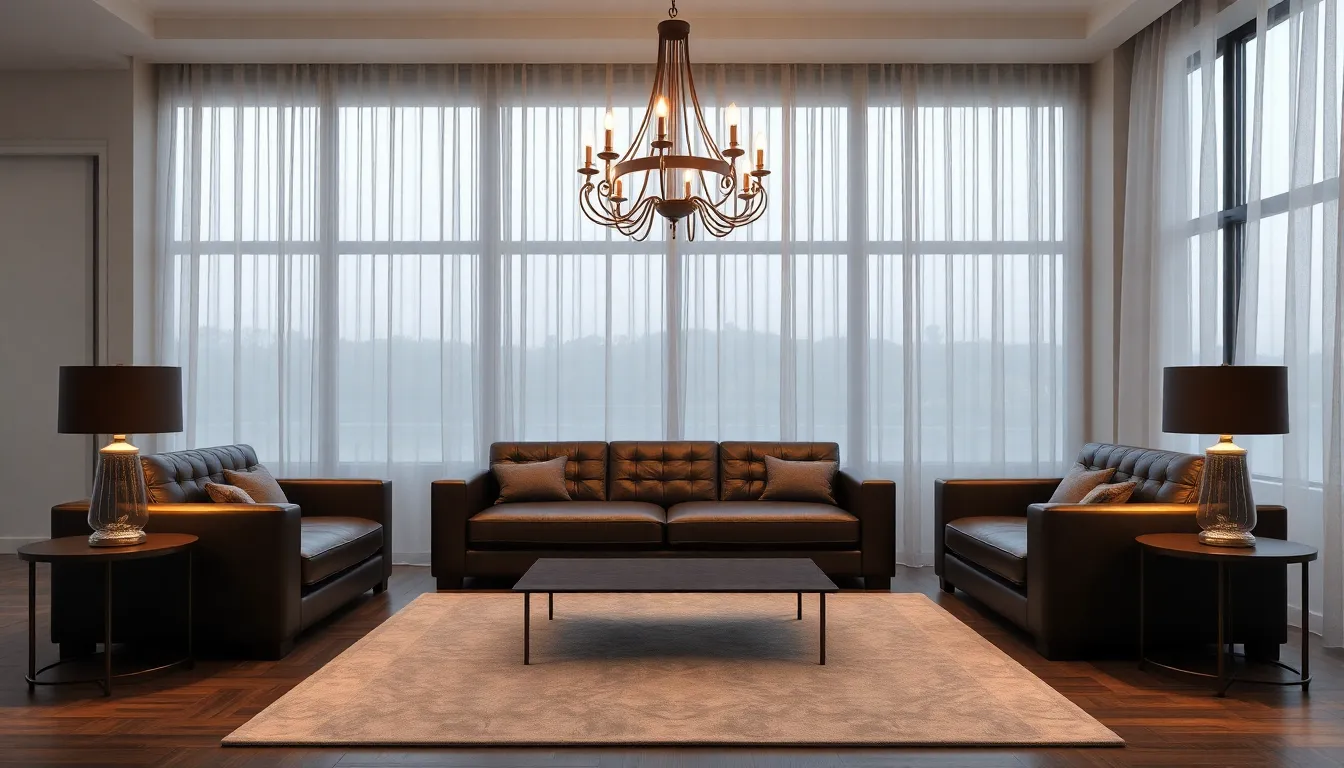
Proper lighting transforms leather sofas from beautiful furniture pieces into stunning focal points that anchor your entire living room design. We’ll explore strategic lighting approaches that highlight your leather sofa’s rich textures while creating the perfect ambiance for any occasion.
Overhead Lighting Options
Chandeliers and pendant lights create dramatic focal points when positioned above your leather sofa seating area. We recommend installing dimmers with these fixtures to adjust brightness throughout the day and create different moods for entertaining or relaxing.
Recessed ceiling lights offer clean, modern illumination that complements contemporary leather sofa designs. Position these lights strategically to avoid casting harsh shadows on your sofa’s surface while providing even ambient lighting across the room.
Track lighting systems deliver flexibility for directing light exactly where you need it most. We suggest angling track lights to graze your leather sofa’s surface, which enhances the material’s natural texture and creates visual depth in your living space.
Table and Floor Lamps
Symmetrical table lamp placement on end tables flanking your leather sofa creates balanced, welcoming illumination. Choose lampshades in neutral tones or metallic finishes that complement your sofa’s leather color, whether it’s rich brown, sophisticated black, or contemporary white.
Floor lamps positioned beside or behind your leather sofa add essential layered lighting while reducing unwanted shadows. We recommend adjustable floor lamps that can direct light upward for ambient lighting or downward for reading and task activities.
Accent lighting from coordinated lamp pairs introduces warmth and visual interest to your leather sofa area. Select lamp bases that harmonize with your room’s design elements, such as wooden bases for rustic spaces or sleek metal for modern aesthetics.
Natural Light Considerations
Window positioning near your leather sofa maximizes daylight exposure, making leather colors appear vibrant and inviting throughout the day. We suggest placing sofas perpendicular to windows rather than directly facing them to prevent glare and protect the leather from excessive sun exposure.
Sheer window treatments soften harsh sunlight while preserving your leather sofa’s finish and preventing fading. These treatments filter natural light beautifully, creating a warm glow that enhances brown and cognac leather tones especially well.
Strategic window orientation impacts how your leather sofa appears at different times. North facing windows provide consistent, cool light that works well with black and white leather, while south facing windows bring warmth that beautifully complements traditional brown leather sofas.
Style with Decorative Accessories
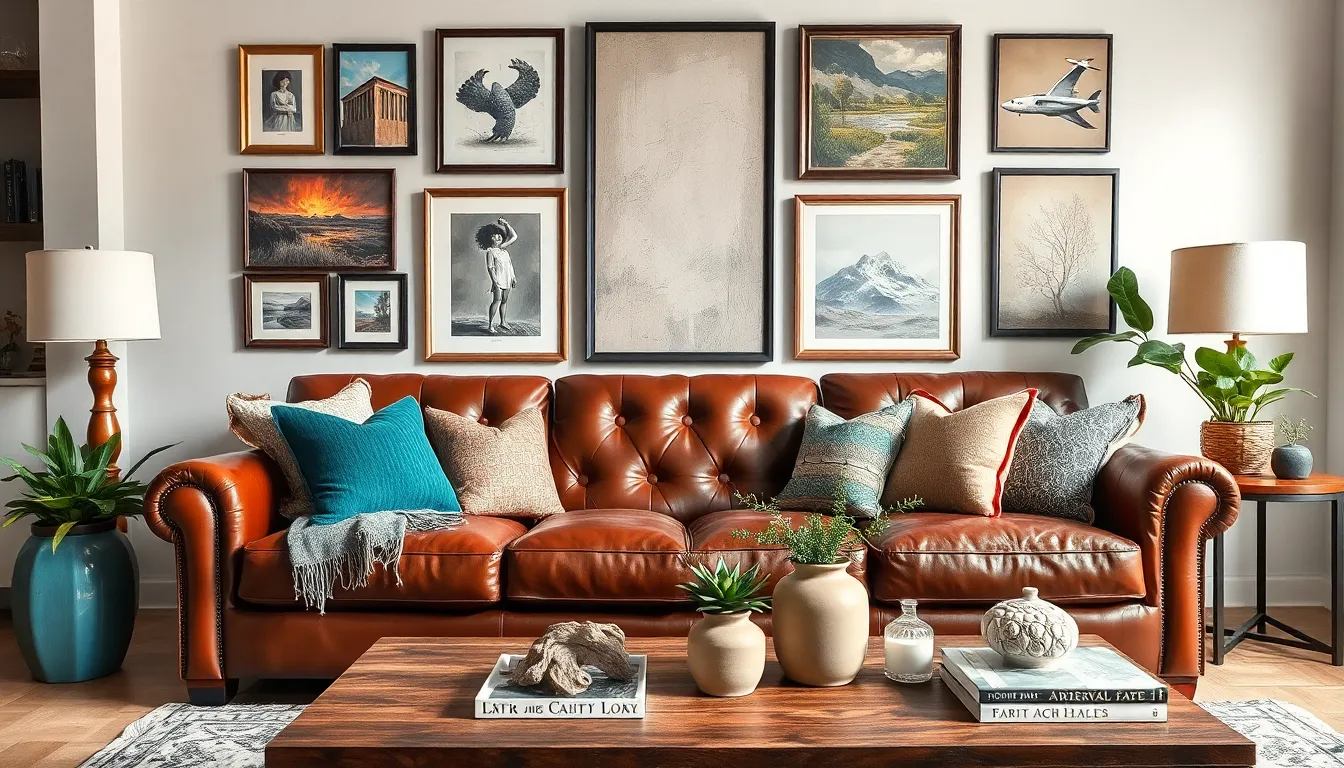
Transforming our leather sofa into a stunning centerpiece requires thoughtful accessory selection that complements its rich texture and timeless appeal. We’ll explore strategic ways to enhance our leather furniture through carefully chosen decorative elements.
Artwork and Wall Decor
Proportion matters significantly when selecting artwork for spaces featuring leather sofas. We recommend choosing pieces that maintain proper scale with both the sofa dimensions and available wall space to create visual harmony.
Color coordination transforms the entire room’s aesthetic by selecting artwork that either complements our leather sofa’s existing tones or introduces harmonious new colors that enhance the overall palette. Earth tones work beautifully with brown leather pieces, while contrasting colors can create ever-changing focal points.
Framing choices influence the sophistication level of our display, so we suggest considering frame materials and styles that echo other elements in the room. Metal frames complement modern leather sofas, while wooden frames enhance traditional or rustic leather pieces.
Arrangement strategies maximize visual impact through thoughtful placement above and around our leather furniture. We can create gallery walls, use single statement pieces, or arrange multiple artworks in geometric patterns to draw attention to our seating area.
Plants and Greenery
Natural elements soften the rugged appearance of leather furniture while introducing organic textures that create visual balance in our living space. Plants provide the perfect counterpoint to leather’s structured lines and rich patina.
Strategic placement enhances both the leather sofa and plant displays by positioning greenery at varying heights around our seating area. Floor plants beside the sofa, hanging plants above, and small potted plants on nearby surfaces create layered natural beauty.
Plant selection complements leather tones through careful consideration of foliage colors and textures. Deep green plants pair beautifully with brown leather, while plants with lighter or variegated leaves can brighten spaces featuring darker leather pieces.
Care considerations ensure our plant choices suit the lighting conditions and maintenance requirements of our living room layout. Low maintenance options like snake plants or pothos work well in spaces where our leather sofa might block some natural light.
Decorative Objects and Collections
Textured combinations create visual interest by pairing leather with complementary materials like wood, woven baskets, or metal accents that add depth to our room’s design story. These layered textures prevent our space from feeling flat or monotonous.
Personal collections reflect our individual style while adding character to the leather sofa area through meaningful objects and curated displays. We can showcase books, vintage finds, or hobby related items that spark conversation.
Display strategies organize our decorative objects using the rule of thirds and varying heights to create pleasing arrangements on coffee tables, side tables, and shelving near our leather furniture. Grouping items in odd numbers typically creates more ever-changing visual appeal.
Material mixing balances the leather’s smooth surface with rough, matte, or glossy textures from ceramics, glass, or natural materials. This contrast keeps our living room design captivating while maintaining the sophisticated feel that leather furniture provides.
Consider Different Design Themes

Design themes provide the foundation for creating cohesive leather sofa living room ideas that reflect your personal style. We’ll explore three popular approaches that showcase how leather sofas can anchor different aesthetic visions.
Industrial Leather Sofa Designs
Exposed elements like metal beams, brick walls, and concrete floors create the perfect backdrop for industrial leather sofa arrangements. Metal pendant lights and Edison bulb fixtures complement the raw materials while highlighting your leather furniture’s rich textures.
Minimal decor works best in industrial spaces, allowing your leather sofa to serve as the primary focal point. We recommend positioning dark brown or black leather pieces against exposed brick to create striking visual contrast.
Raw steel coffee tables and metal shelving units enhance the industrial aesthetic without competing with your leather sofa’s prominence. Factory inspired accessories like vintage scales or industrial clocks complete the urban loft atmosphere.
Rustic and Farmhouse Styles
Natural textures like reclaimed wood and stone pair beautifully with leather sofas in farmhouse inspired living rooms. Earth tones create cozy atmospheres that make cognac and brown leather pieces feel perfectly at home.
Vintage accents such as antique lanterns, weathered picture frames, and barn wood coffee tables enhance the farmhouse appeal. We suggest incorporating woven baskets and cotton throws to soften the leather’s formality.
Shiplap walls and exposed ceiling beams provide architectural interest that complements leather furniture’s timeless quality. Mason jar lighting and galvanized metal accents add authentic farmhouse charm without overwhelming your leather sofa’s elegance.
Mid-Century Modern Approaches
Clean lines define mid-century modern leather sofas, with minimal ornamentation that emphasizes sleek silhouettes. Walnut wood furniture and brass accents create the perfect supporting cast for your leather centerpiece.
Bold geometric artwork complements mid-century leather sofas while adding visual interest to neutral wall colors. We recommend abstract prints and atomic age inspired pieces that echo the era’s optimistic design philosophy.
Neutral colors like whites, grays, and warm beiges balance bold artwork while maintaining the sleek aesthetic. Tulip tables, wire frame chairs, and starburst mirrors complete the mid-century modern look around your leather sofa.
Maintain and Care for Your Leather Sofa Investment
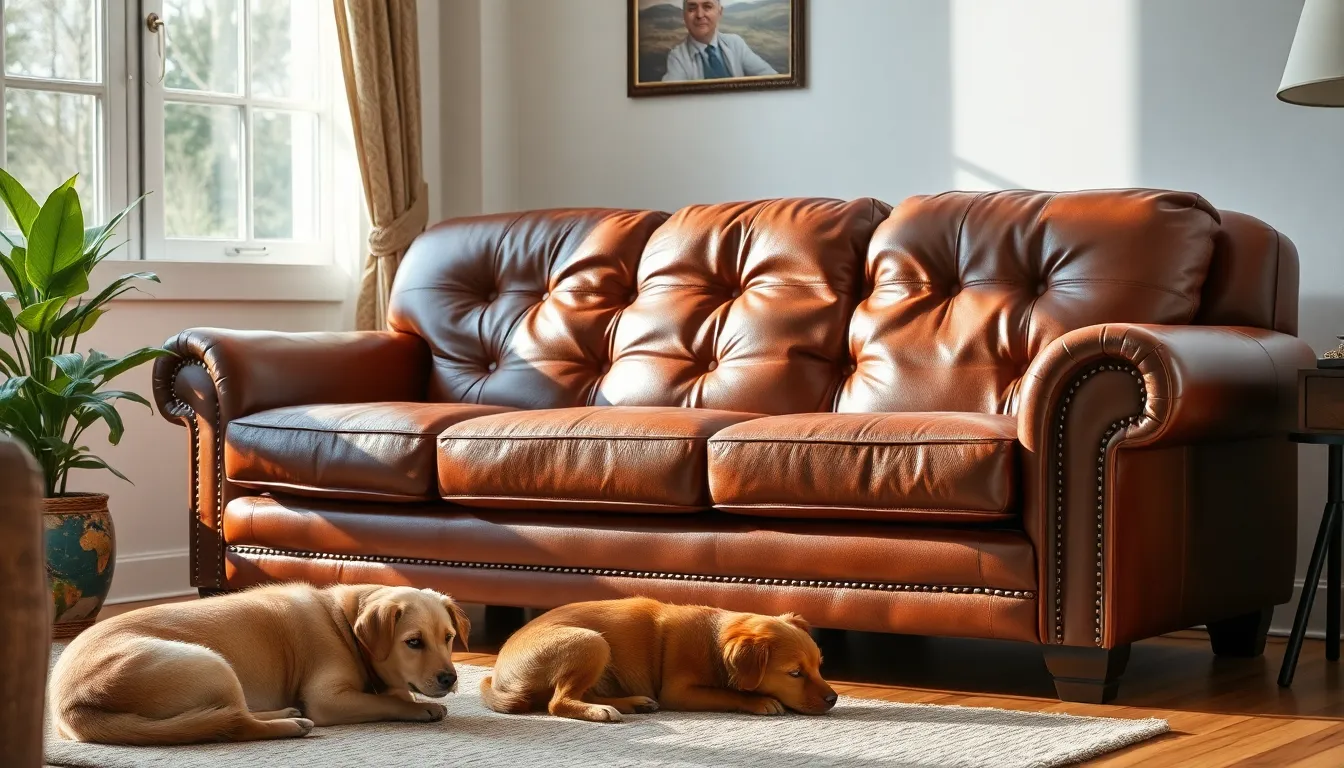
Proper maintenance transforms your leather sofa from a simple furniture piece into a lasting investment that improves with age. We’ll explore essential care practices that preserve both beauty and durability.
Regular Cleaning Routines
Weekly vacuuming removes crumbs and dust from crevices before they settle deep into leather pores. Use your vacuum’s brush attachment on low suction to avoid scratching the surface.
Gentle wiping with a slightly damp cloth eliminates surface dirt and maintains the leather’s natural luster. Avoid harsh chemicals that can strip essential oils and cause cracking over time.
Leather conditioning should occur every 3-6 months to maintain suppleness and prevent drying. Apply a high-quality leather conditioner in circular motions, allowing it to absorb completely before use.
Immediate spill cleanup prevents permanent staining and damage to your investment. Blot spills gently with a clean cloth rather than rubbing, which can spread the liquid deeper into the leather.
Protection from Damage
Direct sunlight exposure causes fading and cracking, so position your leather sofa away from windows or use UV-filtering treatments. Consistent sun exposure can permanently alter leather color and texture.
Floor protection requires placing mats or furniture pads under sofa legs to prevent scratches on hardwood or tile surfaces. These simple additions protect both your sofa and flooring from costly damage.
Temperature control maintains optimal leather conditions by avoiding placement near heating vents or air conditioning units. Extreme temperature fluctuations can cause leather to dry out or become brittle.
Pet considerations include trimming pet nails regularly and using protective covers during shedding seasons. Sharp claws can easily puncture or scratch leather surfaces, creating permanent damage.
Long-Term Maintenance Tips
Cushion rotation ensures even wear patterns by switching positions monthly, extending the overall lifespan of your leather sofa. This practice prevents permanent indentations and maintains consistent comfort levels.
Weight distribution prevents structural damage by avoiding overloading your sofa beyond its intended capacity. Excessive weight can stress frame joints and cause permanent sagging in leather seating areas.
Professional cleaning addresses deep stains and accumulated dirt that regular maintenance can’t handle effectively. Schedule professional service annually or when stains resist your standard cleaning efforts.
Storage considerations protect your leather sofa during moves or extended periods of non-use with breathable covers. Avoid plastic coverings that trap moisture and encourage mold growth on leather surfaces.
Conclusion
We’ve explored the incredible potential of leather sofas to transform your living space into a sophisticated haven that reflects your personal style. From selecting the perfect color and style to mastering the art of complementary design elements these versatile pieces truly serve as the foundation for countless decorating possibilities.
Remember that leather sofas aren’t just furniture – they’re long-term investments that reward thoughtful care and styling. Whether you’re drawn to industrial minimalism rustic charm or mid-century elegance your leather sofa can adapt and evolve with your changing tastes.
By implementing proper maintenance routines and thoughtful accessorizing you’ll ensure your leather sofa remains a stunning centerpiece for years to come. We’re confident these ideas will help you create the living room of your dreams.
Frequently Asked Questions
What makes leather sofas a good investment for living rooms?
Leather sofas are excellent investments because they age beautifully, adapt to changing design trends, and serve as sophisticated focal points. They offer versatility, complementing various design styles from rustic to modern, while providing durability that improves with time. Their timeless appeal and ability to balance different textures and colors make them valuable long-term furniture pieces.
Which leather sofa style is best for small living rooms?
Modern minimalist leather sofas work best for small living rooms due to their clean lines and simple design that doesn’t overwhelm the space. These sofas focus on functionality while maintaining visual lightness. However, sectional sofas can also work in smaller spaces when configured properly to maximize seating without creating visual clutter.
What leather colors are most versatile for different decor styles?
Classic brown leather is the most versatile, working with almost any color scheme and design style. Sophisticated black leather offers dramatic elegance and hides wear well, while contemporary white or light-colored leather creates modern, airy spaces. Brown remains the safest choice for those wanting maximum decorating flexibility.
How do I create a balanced color palette around my leather sofa?
Choose complementary wall colors that enhance your leather tone – warm neutrals for brown leather, crisp whites or grays for black leather. Add accent colors through patterned cushions and throws. Incorporate various textures like throw pillows, blankets, and area rugs to soften the leather’s appearance and create visual interest.
What type of coffee table works best with leather sofas?
Wood coffee tables complement leather beautifully, creating warmth and natural appeal. Metal tables add industrial sophistication, while glass tables provide modern elegance without visual weight. Ensure the table is proportionate to your sofa – typically two-thirds the sofa’s length and positioned 12-18 inches away for optimal function and aesthetics.
How should I light my living room to highlight my leather sofa?
Use layered lighting including overhead options like chandeliers or recessed lights to highlight leather textures. Add table and floor lamps for balanced illumination and ambient lighting. Consider natural light positioning carefully – while it enhances leather colors, direct sunlight can cause fading, so use appropriate window treatments.
What design themes work best with leather sofas?
Industrial themes use exposed elements and minimal decor to highlight leather’s ruggedness. Rustic/farmhouse styles incorporate natural textures and vintage accents for coziness. Mid-century modern focuses on clean lines and bold artwork for sleek aesthetics. Each theme emphasizes different aspects of leather’s versatility and timeless appeal.
How often should I clean and maintain my leather sofa?
Vacuum weekly and wipe with a damp cloth as needed for regular cleaning. Condition leather every 3-6 months to prevent cracking and maintain suppleness. Protect from direct sunlight and heat sources. Rotate cushions regularly for even wear, and consider professional cleaning annually for deep maintenance and longevity.
Can I use plants and accessories to style around leather sofas?
Yes, plants soften leather’s rugged appearance and add organic textures that create visual balance. Choose low-maintenance plants if you’re concerned about care. Decorative objects, artwork, and personal collections add character, but arrange them thoughtfully to avoid clutter while creating focal points that complement your leather sofa’s dimensions and tones.
How do I position a leather sofa in an open concept space?
In open concept layouts, position your leather sofa to define conversation areas while maintaining flow between spaces. Use the sofa as a room divider or anchor piece, and complement it with area rugs to define zones. Consider the sofa’s relationship to other furniture pieces and ensure adequate walking paths around the seating area.

